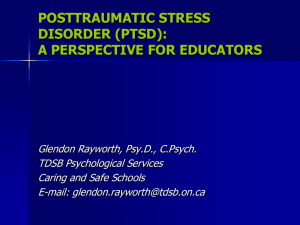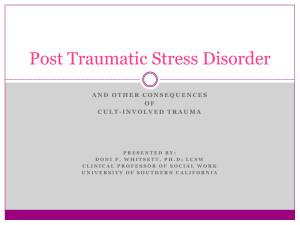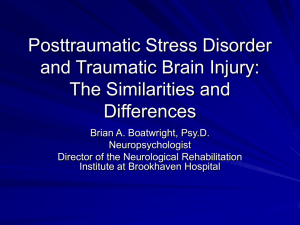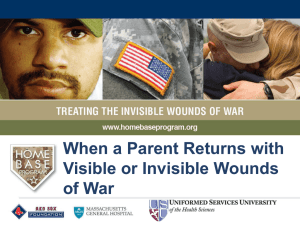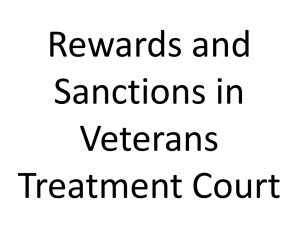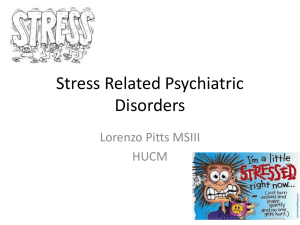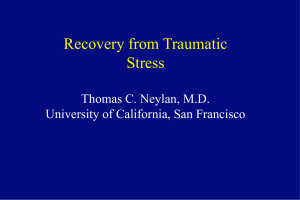Annotated Bibliograpy - Appalachian State University
advertisement
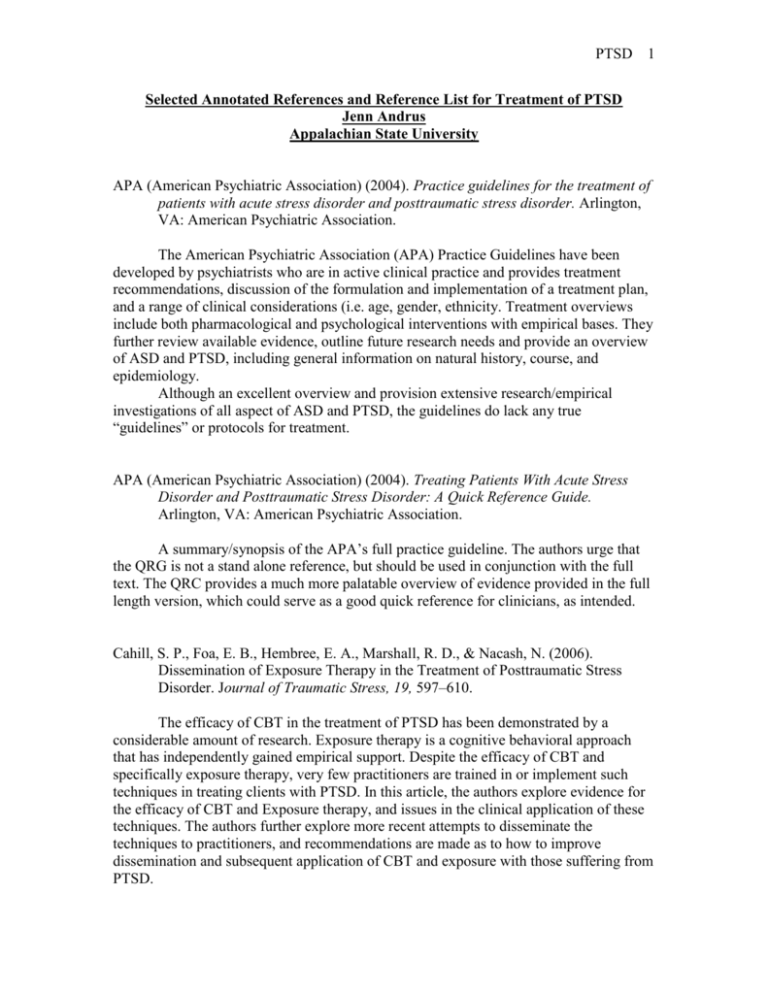
PTSD 1 Selected Annotated References and Reference List for Treatment of PTSD Jenn Andrus Appalachian State University APA (American Psychiatric Association) (2004). Practice guidelines for the treatment of patients with acute stress disorder and posttraumatic stress disorder. Arlington, VA: American Psychiatric Association. The American Psychiatric Association (APA) Practice Guidelines have been developed by psychiatrists who are in active clinical practice and provides treatment recommendations, discussion of the formulation and implementation of a treatment plan, and a range of clinical considerations (i.e. age, gender, ethnicity. Treatment overviews include both pharmacological and psychological interventions with empirical bases. They further review available evidence, outline future research needs and provide an overview of ASD and PTSD, including general information on natural history, course, and epidemiology. Although an excellent overview and provision extensive research/empirical investigations of all aspect of ASD and PTSD, the guidelines do lack any true “guidelines” or protocols for treatment. APA (American Psychiatric Association) (2004). Treating Patients With Acute Stress Disorder and Posttraumatic Stress Disorder: A Quick Reference Guide. Arlington, VA: American Psychiatric Association. A summary/synopsis of the APA’s full practice guideline. The authors urge that the QRG is not a stand alone reference, but should be used in conjunction with the full text. The QRC provides a much more palatable overview of evidence provided in the full length version, which could serve as a good quick reference for clinicians, as intended. Cahill, S. P., Foa, E. B., Hembree, E. A., Marshall, R. D., & Nacash, N. (2006). Dissemination of Exposure Therapy in the Treatment of Posttraumatic Stress Disorder. Journal of Traumatic Stress, 19, 597–610. The efficacy of CBT in the treatment of PTSD has been demonstrated by a considerable amount of research. Exposure therapy is a cognitive behavioral approach that has independently gained empirical support. Despite the efficacy of CBT and specifically exposure therapy, very few practitioners are trained in or implement such techniques in treating clients with PTSD. In this article, the authors explore evidence for the efficacy of CBT and Exposure therapy, and issues in the clinical application of these techniques. The authors further explore more recent attempts to disseminate the techniques to practitioners, and recommendations are made as to how to improve dissemination and subsequent application of CBT and exposure with those suffering from PTSD. PTSD 2 Foa E. B, Davidson, J. R. T., & Frances A. (1999) The Expert Consensus Guideline Series: Treatment of Posttraumatic Stress Disorder. Journal of Clinical Psychiatry, 60, 1-75. This publication is based on surveys from over 50 experts on 58 questions related to psychotherapy and medication treatment of PTSD. It covers diagnosis, selecting treatment, treatment “trouble shooting”, and issues in primary care. The manuscript is easy to read, with results for each area table for easy reference and decision making. It further offers a guide for patients and families that would serve well as a reference for a clinician, or as a hand out for clients in the psychoeduction phase of treatment. Foa, E. B., Keane, T. M., & Freidman, M. J. (2000). Effective Treatments for PTSD: Practice guidelines from the International Society for Traumatic Stress Studies. New York: Guildford. Viewed as the gold standard of texts regarding the treatment of PTSD today, from the leading researcher (Foa), and research society for PTSD (ITSS). This edited text evaluates efficacy and provides guidelines for both established and emerging treatment approaches for the disorder. It outlines empirical and practical strengths and weaknesses, as well areas needing further exploration, for all the reviewed approaches. Practitioners may find the Course of Treatment and Recommendations sections for each approach in section 2 helpful for discerning appropriateness of different modalities with different clients. Resick, P., & Calhoun, K., S. (2001). Posttraumatic stress disorder. In D. Barlow (Ed.), Clinical Handbook of Psychological Disorders (pp. 60-113) New York: Guilford. This chapter provides an overview of diagnosis and prevalence, theoretical models, assessment, and treatments of PTSD. The treatment section provides outlines for Stress Inoculation Training, Exposure Techniques, Cognitive Processing Therapy, and Eye Movement Desensitization and Reprocessing, and offers excellent overviews of empirical support. Although it does provide some guidance as to technique, the text does lack a succinct “how to” for clinicians. The chapter further considers therapist, client, and setting variables critical for consideration in treatment development. The chapter concludes with a thorough case study which applies Cognitive Processing Therapy (CPT) and provides an excellent session by session overview of both specific treatment protocols and application to a case of rape related PTSD, which clinicians may find helpful in conceptualizing a CPT treatment protocol. PTSD 3 Richard, D. C. S., & Lauterbach, D. L. (Eds.) (2007). Handbook of Exposure Therapies. San Diego, Academic Press. This edited text provides an excellent overview of the applications of exposure therapy. Although not limited to PTSD, several chapters do focus specifically on the disorder. In addition to Chapter 5: Exposure Therapy and Posttraumatic Stress Disorder, Chapter 6 focuses on Exposure therapy with Adult Survivors of Childhood Sexual Abuse and Chapter 7 focuses on Combat Veteran PTSD. Additionally, chapters are dedicated to the describing the technique, enhancing effectiveness in the implementation of the technique, and the effects of pharmacotherapy in Exposure Therapy, all helpful chapters for clinicians to review despite disorder they seek to treat with exposure. A chapter on virtual reality applications of exposure highlights PTSD, and is useful for clinicians in consideration of recent advancements and applications specifically in this area for PTSD. VA/DoD (Department of Veterans Affairs/Department of Defense) (2004). VA/DoD Clinical practice guideline for the management of posttraumatic stress, version 1.0. Washington, DC: Veterans Health Administration, Department of Defense. This Guideline was designed by and for mental health providers, primary care clinicians, chaplains, pharmacists, and other professionals to be a comprehensive and evidenced based resource for identifying, assessing, and/or treating military men, women and veterans who have survived traumatic events. It offers a decision tree for prevention, assessment, and treatment with full annotations across a broad range of posttraumatic disorders. The Guideline provides clear rationales and overviews, and outlines of various aspects of primary, secondary and tertiary interventions. Recommendations with supporting studies citations are tabled for easy review. Guidelines are divided in to modules for appropriate diagnositc categories relevant to this population: Initial Evaluation and Triage; Acute Stress Reaction (ASR); Combat and Ongoing Operation Stress Reaction (COSR); Acute Stress Disorder (ASD) and Post-Traumatic Stress Disorder (PTSD) in Primary Care; Management of PTSD in Mental Health Specialty Care. The appendix includes various screening tools, several which can be used with “civilian” populations. Violanti, J. M., & Paton, D. (2006). Who gets PTSD? Issues of Posttraumatic Stress Vulnerability. Springfield, Illinois: Thomas Books. Many occupations today involve responses to emergency situations, of which may be deemed traumatic. Natural disasters, terrorism, and other daily tragedies, expose those involved in war or rescue operations around the world to such horrific events. This edited text explores the multifinality of exposure to trauma in attempts to explain why some result in PTSD where as others do not. Contributing authors explain societal influences, individual difference, and other risk factors both generally and in specific application to PTSD 4 occupations such as police officers, military personnel, international aid workers, and social services. Wilson, J. P., Freidman, M. J., & Lindy, J. D. (Eds.) (2001) Treating psychological trauma and PTSD. New York: Guildford. This edited text focuses on the clinical treatment of trauma and PTSD, and is organized in to four sections 1) theory, models, and clinical paradigms, 2) clinical treatment 3) approaches for special populations, and 4) case analysis and practical considerations. Most noteworthy is the overview of special populations and the provision of case studies throughout the text. Chapter 15: Case History Analysis of the Treatments for PTSD: Lessons Learned, chapter examines common features of core approaches among 27 case histories, treated with different approaches (psychopharmalogical, psychoanalytic/dynamic, CBT, constructivist, dual diagnosis, culturally specific, family/couple, group). Chapter 16: Practical Considerations in the Treatment of PTSD: Guidelines for Practitioners is a good overview of treatment approaches and considerations for clinicians, and table that may be useful for treatment approach decision making which outline treatment type, symptom targets, and treatments goals at a glance. References APA (American Psychiatric Association) (2000). Diagnostic and Statistical Manual of Mental Disorders, 4th Edition, Text Revised. Washington DC: American Psychiatric Association. APA (American Psychiatric Association) (2004). Practice guidelines for the treatment of patients with acute stress disorder and posttraumatic stress disorder. Arlington, VA: American Psychiatric Association. APA (American Psychiatric Association) (2004). Treating Patients With Acute Stress Disorder and Posttraumatic Stress Disorder: A Quick Reference Guide. Arlington, VA: American Psychiatric Association. Australian Centre for Posttraumatic Mental Health. (2007). Australian Guidelines for the Treatment of Adults with Acute Stress Disorder and Posttraumatic Stress Disorder. ACPMH, Melbourne, Victoria. Cahill, S. P., Foa, E. B., Hembree, E. A., Marshall, R. D., & Nacash, N. (2006). Dissemination of Exposure Therapy in the Treatment of Posttraumatic Stress Disorder. Journal of Traumatic Stress, 19, 597–610. PTSD 5 Freidman, M. J. (2004). Acknowledging the Psychiatric Cost of War. New England Journal of Medicine, 351, 75-77. 1-76. Foa E. B, Davidson, J. R. T., & Frances A. (1999) The Expert Consensus Guideline Series: Treatment of Posttraumatic Stress Disorder. Journal of Clinical Psychiatry, 60, 1-75. Foa, E. B., Keane, T. M., & Freidman, M. J. (2000). Effective Treatments for PTSD: Practice guidelines from the International Society for Traumatic Stress Studies. New York: Guilford. Kessler, R.C, Sonnega A., Bromet E., Hughes M., & Nelson, C.B. (1995). Posttraumatic stress disorder in the National Comorbidity Survey. Archives of General Psychiatry, 52, 1048-1060. Krupnick, J., L. (2001). Interpersonal psychotherapy for PTSD after interpersonal trauma. Directions in Psychiatry, 20, 237-253. Resick, P., & Calhoun, K., S. (2001). Posttraumatic stress disorder. In D. Barlow (Ed.), Clinical Handbook of Psychological Disorders (pp. 60-113) New York: Guilford. Richard, D. C. S., & Lauterbach, D. L. (Eds.) (2007). Handbook of Exposure Therapies. San Diego: Academic Press. NCTSN/NCPTSD (National Child Traumatic Stress Network and National Centre for PTSD) (2006). Psychological First Aid: Field operations guide. Retrieved from from www.ncptsd.va.go on February 4, 2008 NICE (National Institute for Clinical Excellence) (2005). The Management of PTSD in Adults and Children in Primary and Secondary Care (Vol. 26). Wilshire: Cromwell Press Ltd. Solomon, Z., Horesh, D. (2007). Changes in the Criteria of PTSD: Implications from two longitudinal studies. American Journal of Orthopsychiatry, 77, 182-188. VA/DoD (Department of Veterans Affairs/Department of Defense) (2004). VA/DoD Clinical practice guideline for the management of posttraumatic stress, version 1.0. Washington, DC: Veterans Health Administration, Department of Defense. Violanti, J. M., & Paton, D. (2006). Who gets PTSD? Issues of Posttraumatic Stress Vulnerability. Thomas Books: Springfield Illinois. Wilson, J. P., Freidman, M. J., & Lindy, J. D. (Eds.) (2001). Treating psychological trauma and PTSD. New York: Guilford.

